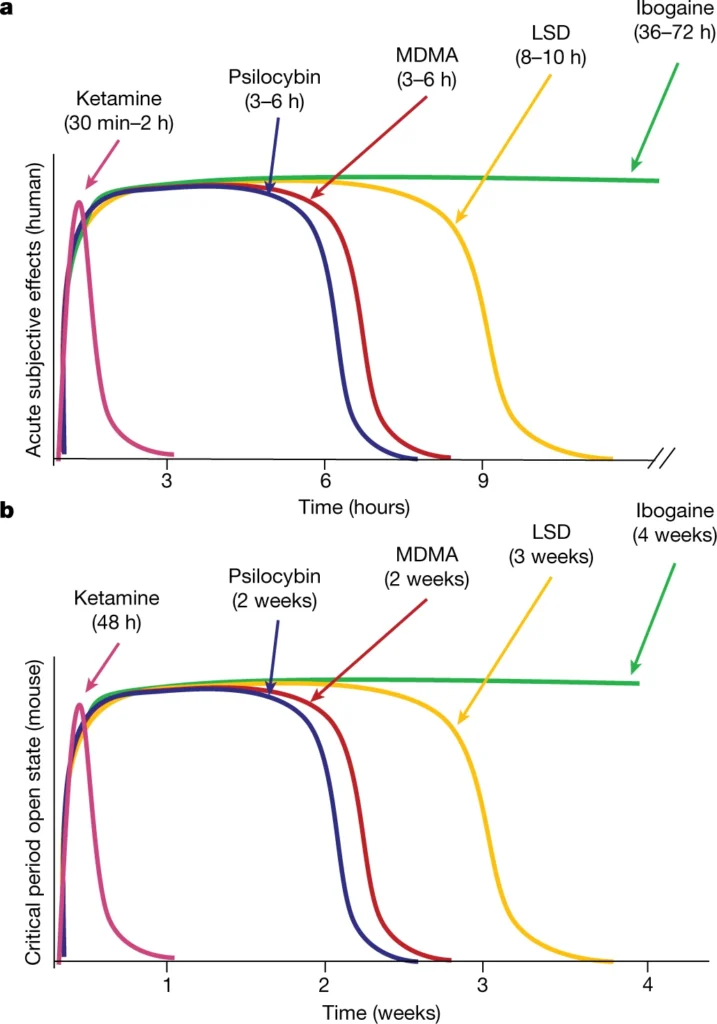By Katie Pickard, Director of Education
Psychedelic plant medicines like psilocybin, ayahuasca, and mescaline have been used for centuries in spiritual and healing traditions. Today, they are gaining recognition for their potential to support mental health, personal growth, and trauma healing. However, a therapeutic psychedelic journey is more than just taking a substance. The process involves careful planning, intention, and integration.
If you’re new to this world, understanding the key steps in the process can help you approach it with awareness and responsibility. Below, we break down the essential phases of a therapeutic psychedelic journey, including typical timeframes and activities for each step.

1. Research (1 week – several months)
Before embarking on a psychedelic journey, it’s essential to educate yourself about the medicine, its effects, and potential risks.
Typical activities:
- Reading books, scientific studies, and anecdotal experiences
- Listening to podcasts or attending educational webinars
- Consulting experts, facilitators, or therapists
- Researching legal considerations and safe access points
- Exploring different plant medicines to determine what aligns with your needs
2. Preparation (1 – 4 weeks)
This phase is about preparing your body, mind, and environment for the psychedelic experience. The depth of preparation depends on the substance, your personal background, and the level of therapeutic support available.
If you’re looking for personalized guidance and support before a psychedelic experience, the Unlimited Sciences Psychedelic Info Line offers free, 1:1 support for answering questions about psychedelic safety, integration, and emotional processing.
Typical activities:
- Dietary adjustments (Dieta): Avoiding processed foods, caffeine, alcohol, and certain medications (especially for ayahuasca or iboga)
- Psychological preparation: Journaling, meditating, or working with a therapist to surface relevant intentions and emotions
- Physical preparation: Engaging in activities like yoga, breathwork, or nature walks to connect with your physical body
- Logistics: Choosing a guide, retreat, or safe space for the experience and arranging post-journey support
3. Set and Setting (Immediate Environment, Day of the Journey)
“Set” refers to your mindset, while “setting” refers to your physical and social environment. These factors significantly influence your experience.
Typical activities:
- Mindset (Set): Practicing gratitude, reaffirming intentions, and letting go of expectations
- Physical Environment (Setting): Choosing a comfortable, safe, and aesthetically pleasing space with calming elements like nature sounds, blankets, or dim lighting
- Community: Deciding whether to journey alone, with a guide, or in a group setting
- Safety Measures: Ensuring access to water, soft music, a journal, and emergency contacts if needed
4. Intention (The Core of the Experience)
Setting an intention is about clarifying what you hope to gain from the journey. Intentions guide the experience but should be held lightly—psychedelics often provide what you need rather than what you expect.
Typical activities:
- Reflecting on questions like:
- What am I seeking from this experience?
- What patterns or emotions do I want to explore?
- How can I cultivate self-compassion during challenging moments?
- Writing a simple intention statement (e.g., “I am open to healing and insight.”)
- Meditating on or repeating the intention before and during the journey
5. The Experience (4–12 hours, depending on the medicine)
The peak psychedelic experience varies in length depending on the substance:
- Psilocybin: 4–6 hours
- LSD: 8–12 hours
- Ayahuasca: 4–6 hours per ceremony (often multiple nights)
- MDMA-assisted therapy: 6–8 hours
Typical activities:
- Surrendering: Letting go of resistance and trusting the process
- Engaging with the experience: Observing visions, emotions, or insights as they arise
- Breathing and grounding techniques: Using slow breaths or body awareness to navigate intensity
- Journaling or drawing: If the experience allows, recording thoughts or images that surface
- Supportive presence: If guided, interacting with a sitter or therapist as needed
6. Integration (Days to Months)
The most crucial part of the journey happens after the medicine wears off. Integration is the process of applying insights and healing from the experience into daily life. Without integration, even profound experiences may fade without meaningful impact.
Typical activities:
- Journaling: Reflecting on key insights and feelings
- Talking with a trusted friend, therapist, or integration coach
- Engaging in grounding practices: Meditation, movement, nature walks, or creative expression
- Making life adjustments: Changing habits, relationships, or mindsets based on new perspectives
- Continuing education and support: Reading, attending integration circles, or working with a community
To add some neuroscience to this topic, you can reference the fantastic paper Psychedelics reopen the social reward learning critical period (Nardou et al., 2023). Here are some highlights of what the researchers found:
- The subjective effects of psilocybin last for 3-6 hours, but have a critical period of approximately 2 weeks.
- The first few weeks of integration practices may be the most critical for the biological components of psilocybin.
- During this period, the brain is particularly adept at learning from social interactions, which is essential for developing social skills and behaviors.
- Psychedelic effects might be mediated by their ability to induce hyperplasticity: A state of heightened neuroplasticity where the brain exhibits an increased ability to reorganize and form new neural connections.
- Hyperplasticity can facilitate rapid learning and recovery from brain injuries but may also increase vulnerability to maladaptive neural changes, such as those seen in certain mental health disorders.
- The ability to reopen the social reward learning critical period is a shared property across psychedelic drugs. Critical periods are developmental phases when the brain is exceptionally plastic, making it highly receptive to learning and environmental influences.

Final Thoughts
A therapeutic psychedelic journey is a deep and transformative process, requiring thoughtful preparation and integration. If you’re considering this path, take the time to educate yourself, seek guidance from experienced practitioners, and honor the sacred nature of these medicines.
If you’re looking for personalized guidance and support before or after a psychedelic experience, the Unlimited Sciences Psychedelic Info Line offers free, 1:1 support for answering questions about psychedelic safety, integration, and emotional processing.
